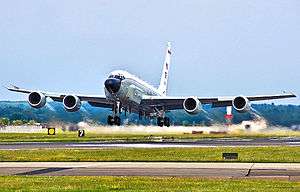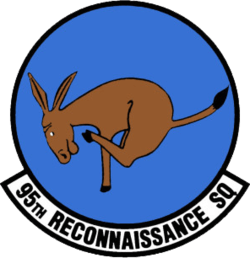95th Reconnaissance Squadron
The 95th Reconnaissance Squadron is a squadron of the United States Air Force. It is assigned to the 55th Operations Group, Air Combat Command, stationed at Offutt Air Force Base, Nebraska. The squadron is equipped with several variants of the Boeing C-135 aircraft equipped for reconnaissance missions.[1]
95th Reconnaissance Squadron
 | |
|---|---|
 95th Reconnaissance Squadron RC-135V Rivet Joint ISR aircraft. | |
| Active | 1917–1919; 1919–1927; 1928–1945; 1947–1948; 1952–1958; 1982–1993; 1994–present |
| Country | |
| Branch | |
| Type | Squadron |
| Role | Reconnaissance |
| Part of | Air Combat Command |
| Garrison/HQ | RAF Mildenhall |
| Nickname(s) | Kickin' Ass |
| Tail Code | "OF" |
| Engagements |
|
| Decorations |
|
| Insignia | |
| 95th Reconnaissance Squadron emblem (approved 24 March 1924)[1][note 1] |  |
The 95th is one of the oldest units in the United States Air Force, first being organized as the 95th Aero Squadron on 20 August 1917 at Kelly Field, Texas. The squadron deployed to France and fought on the Western Front during World War I as a pursuit squadron.[2]
During World War II the unit served in the Mediterranean Theater of Operations (MTO) as part of Twelfth Air Force as a B-26 Marauder light bomber squadron, participating in the North African and the Southern France Campaign. In the Cold War, the squadron fought in the Korean War with Douglas B-26 Invader medium bombers, then later as part of Strategic Air Command, flying TR-1A Dragonlady reconnaissance aircraft supporting NATO.[3]
Mission
Conducts RC-135 Rivet Joint flight operations in the European and Mediterranean theaters of operations as tasked by National Command Authorities and European Command. Provides all operational management, aircraft maintenance, administration, and intelligence support to produce politically sensitive real-time intelligence data vital to national foreign policy. Supports EC-135, OC-135 Open Skies, and Boeing E-4B missions when theater deployed.
Although it is a component of the 55th Operations Group, main flying operations are conducted from RAF Mildenhall, United Kingdom and Souda Bay, Crete.
History
World War I
The 95th was originally activated as the 95th Aero Squadron (a fighter unit) on 20 August 1917 at Kelly Field in Texas. It deployed to various locations in France during World War I, initially at Issoudun Aerodrome. On 5 May 1918, it was assigned to the 1st Pursuit Group. Well-known pilots with the 95th Aero Squadron who perished in World War I included Lt. Quentin Roosevelt, the youngest son of President Theodore Roosevelt, and Irby Curry. Both of them died while the squadron was based in Saints Aerodrome, France. A number of aces also served with the unit, including Lansing Holden, Sumner Sewall, Harold Buckley, Edward Peck Curtis, James Knowles, and one of its commanding officers, Captain David M. Peterson.[4]
After the war ended on 11 November 1918, the 95th Aero Squadron was demobilized on 18 March 1919. As the 95th Pursuit Squadron it conducted bombing missions on the Clinton River to prevent flooding in communities near the river caused by an ice jam. As the 95th Attack Squadron, it flew reconnaissance missions in March 1938 to support flood relief operations in southern California.[5]
Interwar years
The 95th Aero Squadron underwent various activations and inactivations over the years and experienced numerous name changes.
World War II
During World War II, it was known as the 95th Bombardment Squadron (Medium) and was a squadron in the 17th Bombardment Group that provided North American B-25 Mitchells and 6 crews for the Doolittle Raid and later flew the Martin B-26 Marauder in the Mediterranean Theater of Operations.
Korean War
Reconnaissance operations
After being inactivated on 25 June 1958, it was redesignated as the 95th Reconnaissance Squadron on 20 January 1982 and reactivated at RAF Alconbury in the United Kingdom on 1 October 1982. It flew Lockheed U-2 and TR-1 aircraft in support of NATO and United States Air Forces Europe missions. After the end of the Cold War, the 95th was no longer needed and the unit was inactivated on 15 September 1993. This hiatus did not last long as the unit was reactivated on 1 July 1994 at RAF Mildenhall, this time flying the RC-135 Rivet Joint and OC-135 Open Skies aircraft.
Lineage
- Organized as the 95th Aero Squadron (Pursuit) on 20 August 1917
- Redesignated as: 95th Aero Squadron (Pursuit), on 5 March 1918
- Demobilized on 18 March 1919<[2]
- Reconstituted[5] and organized on 12 August 1919
- Redesignated 95th Squadron (Pursuit) on 14 March 1921
- Redesignated 95th Pursuit Squadron on 30 September 1922
- Redesignated 95th Pursuit Squadron, Air Service on 25 January 1923
- Redesignated 95th Pursuit Squadron, Air Corps on 8 August 1926
- Inactivated on 31 July 1927
- Redesignated 95th Pursuit Squadron and activated, on 1 June 1928
- Redesignated 95th Attack Squadron on 1 March 1935
- Redesignated 95th Bombardment Squadron (Medium) on 17 October 1939
- Redesignated 95th Bombardment Squadron, Medium on 9 October 1944
- Inactivated on 26 November 1945
- Redesignated 95th Bombardment Squadron, Light on 29 April 1947
- Activated on 19 May 1947
- Inactivated on 10 September 1948
- Redesignated 95th Bombardment Squadron, Light, Night Intruder on 8 May 1952
- Activated on 10 May 1952
- Redesignated 95th Bombardment Squadron, Tactical on 1 October 1955
- Inactivated on 25 June 1958
- Redesignated 95th Reconnaissance Squadron on 20 January 1982
- Activated on 1 October 1982
- Inactivated on 15 September 1993
- Activated on 1 July 1994[6]
Assignments
|
|
Stations
|
|
Aircraft
- Nieuport 28, 1917–1918
- SPAD S.XIII, 1918, 1919
- Royal Aircraft Factory S.E.5, 1919–1922
- Thomas-Morse MB-3, 1922–1925
- Fokker D.VII, 1919–1925
- Dayton-Wright DH-4, 1919–1925
- Curtiss PW–8 Hawk, 1924–1926
- Curtiss P-1 Hawk, 1925–1927
- Boeing PW-9, 1928–1929
- Boeing P-12, 1929–1934, 1935–1936
- Boeing P-26 Peashooter, 1934–1935
- Northrop A-17, 1936–1939
- Douglas B-18 Bolo, 1939–1940
- Douglas B-23 Dragon, 1940–1941
- North American B-25 Mitchell, 1941–1942
- Martin B-26 Marauder, 1942–1945
- Douglas B-26 Invader, 1952–1956
- Douglas B-66 Destroyer, 1956–1958
- Lockheed U-2, 1991–1993
- Lockheed TR-1, 1991–1993[1]
- Boeing RC-135U Combat Sent, 1994–present
- Boeing RC-135V Rivet Joint, 1994–present
- Boeing RC-135W Rivet Joint, 1994–present
- Boeing OC-135B Open Skies, 1994–present
See also
- List of American Aero Squadrons
References
- Notes
- In the original version of the emblem, the mule's ears and tail projected outside the disc. The current emblem was reviewed by the United States Air Force Chief of Staff in 1991. Bailey. The emblem is based on the emblem approved for the 95th Aero Squadron by the American Expeditionary Forces on 19 November 1918. Maurer, Combat Squadrons, p. 318.
- Per Gorrell. Maurer and Bailey both indicate that the assignment to the 1st Pursuit Group lasted until 24 December 1919.
- Maurer says the squadron was attached to the 7th Bombardment Group. Bailey describes this attachment as "possible", but neither Maurer nor Bailey give a unit of assignment. Clay indicates the squadron was again assigned to the 1st Pursuit Group. Maurer, Combat Squadrons, p. 317; Bailey; Clay, p. 1436.
- Both Maurer and Clay indicate that the squadron remained at March Field after moving there in October 1931. Maurer, Combat Squadrons, p. 317; Clay, p. 1436.
- Citations
- Bailey, Carl E. (10 July 2017). "Factsheet 31 Fighter Wing (USAFE)". Air Force Historical Research Agency. Retrieved 31 August 2017.
- Gorrell
- Maurer, Combat Squadrons, pp. 316–318
- Franks, p. 86
- Clay, p. 1436
- Lineage in Bailey, except as noted.
- Assignments through November 1917 in Gorrell.
- Assignments from December 1918 through demobilization in Gorrell.
- Assignments in Bailey, except as noted.
- Station number in Johnson.
- Station number in Endicott, p. 178.
- Stations in Bailey, except as indicated.
Bibliography
![]()
- Clay, Steven E. (2011). US Army Order of Battle 1919–1941 (PDF). Vol. 3 The Services: Air Service, Engineers, and Special Troops 1919–1941. Fort Leavenworth, KS: Combat Studies Institute Press. ISBN 978-0-98419-014-0. LCCN 2010022326. OCLC 637712205. Archived from the original (PDF) on 27 September 2013. Retrieved 16 October 2012.
- Endicott, Judy G., ed. (2001). The USAF in Korea, Campaigns, Units and Stations 1950–1953 (PDF). Maxwell AFB, AL: Air Force Historical Research Agency. ISBN 0-16-050901-7. Retrieved 17 December 2016.
- Franks, Norman (2001). American Aces of World War I. Dempsey, Harry (illustrator). Oxford, England: Osprey Publishing. ISBN 978-1841763750.
- Gorrell, Col. Edgar S. (1974). History of the American Expeditionary Forces Air Service, 1917-1919. Series E: Squadron Histories. Vol. 13 History of the 95th Aero Squadron. Washington, DC: National Archives and Records Service, General Services Administration. OCLC 215070705.
- Johnson, 1st Lt. David C. (1988). U.S. Army Air Forces Continental Airfields (ETO) D-Day to V-E Day (PDF). Maxwell AFB, AL: Research Division, USAF Historical Research Center. Archived from the original (PDF) on 29 September 2015. Retrieved 26 June 2017.
- Maurer, Maurer, ed. (1983) [1961]. Air Force Combat Units of World War II (PDF) (reprint ed.). Washington, DC: Office of Air Force History. ISBN 0-912799-02-1. LCCN 61060979. Retrieved 17 December 2016.
- Maurer, Maurer, ed. (1982) [1969]. Combat Squadrons of the Air Force, World War II (PDF) (reprint ed.). Washington, DC: Office of Air Force History. ISBN 0-405-12194-6. LCCN 70605402. OCLC 72556. Retrieved 17 December 2016.
- Ravenstein, Charles A. (1984). Air Force Combat Wings, Lineage & Honors Histories 1947-1977. Washington, DC: Office of Air Force History. ISBN 0-912799-12-9. Retrieved 17 December 2016.
- War Department (1920). Battle Participation of Organizations of the American Expeditionary Forces in France, Belgium and Italy, 1917–1919. Washington DC: Government Printing Office. OCLC 118250. Retrieved 4 December 2016.